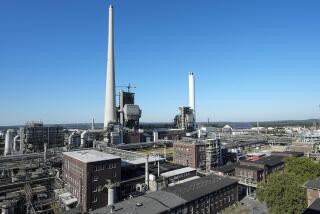E. Germans Must Act Fast to Preserve History
- Share via
EAST BERLIN — East Germany’s historic monuments and old buildings are crumbling almost as fast as its Communist political system.
Whole streets in cities and towns have been razed for fear that buildings may collapse after decades of neglect.
The southern city of Dresden has torn down as many buildings in the last 40 years as it lost in World War II in bombing raids that wiped out 80% of its downtown.
“Desperate measures are needed on a scale that East Germany simply has no resources to provide at the moment,” Culture Minister Dietmar Keller wrote recently in a plea for help to the United Nations’ cultural organization, UNESCO, and the Council of Europe.
In the vocabulary of East Germany’s new reformist leaders, denkmalpflege (upkeep of monuments) has become a symbol for renewed national pride and determination to save the country from collapse.
The new leadership blames the crisis on the ousted hard-liners and their 40 years of misguided housing policies, industrial pollution and neglect.
“We have not protected the monuments handed down to us from the past as we should have,” Keller wrote in an appeal for Weimar, the medieval town where literary giants Goethe and Schiller lived and which was briefly the German capital.
In Weimar, as in several towns displaying the riches of the Duchy of Brandenburg and the might of imperial Germany, city officials have launched an emergency fund to save their heritage.
Similar funds, inviting tax-deductible contributions from individuals, local businesses and international bodies, have sprouted in recent weeks in Dresden and Meissen.
Like the protest movements that ousted hard-line leader Erich Honecker and forced the opening of East Germany’s borders, the funds are run by intellectuals and artists tired of waiting for cash from a creaking central bureaucracy.
“We must each contribute single-mindedly to the revival of our city, with our hearts, our heads and our bare hands,” said Klaus Daeumer of “Save Meissen Now,” which is raising money to restore the cathedral and castle of the town famed as a porcelain center.
In Erfurt, bulldozers knocked down buildings last March because there was no money for their upkeep. Dresden destroyed more than 5,000 old buildings last year, leaving just a quarter of the houses that stood in the 1930s.
Leipzig has yet to rebuild its old town hall which was partly destroyed in the war, one of thousands of bomb sites in East Germany that have not been cleared.
Even in the capital, East Berlin, scaffolding props up about 8,000 houses. In the working-class quarter of Prenzlauer Berg, 16,000 balconies are deemed dangerous and 4,000 more have been torn down. House after house is empty, roofs leak, plaster flakes off facades and rust gnaws at the bars of windows.
East German cities, bombed by the Americans and British, then overrun by the Soviet army, suffered some of the worst damage of World War II. But some old centers, notably Dresden and East Berlin, were partly rebuilt with Western aid.
In the 1950s and 1960s, East Germany embarked on an ambitious housing construction program. However, one result was to leave older buildings empty and untended.
Air pollution has been a further scourge. Sulfur dioxide fumes from open-cast brown coal mines burn the eyes and throats of city dwellers and eat away at buildings.
The old regime concentrated on restoring one or two main streets in each city, investing heavily in a few prestige projects and leaving side streets a shoddy mess.
Berlin Cathedral, which reopened in 1987, cost the equivalent of $17 million to restore. It is only one of 48,000 listed national monuments.
Although lacking machinery and strapped for cash, the new reformist government has given some signs of hope.
Squatters, outlawed under Honecker but now tolerated, are repairing abandoned buildings in several cities because their “modern” homes have begun falling apart.
More to Read
Sign up for Essential California
The most important California stories and recommendations in your inbox every morning.
You may occasionally receive promotional content from the Los Angeles Times.













